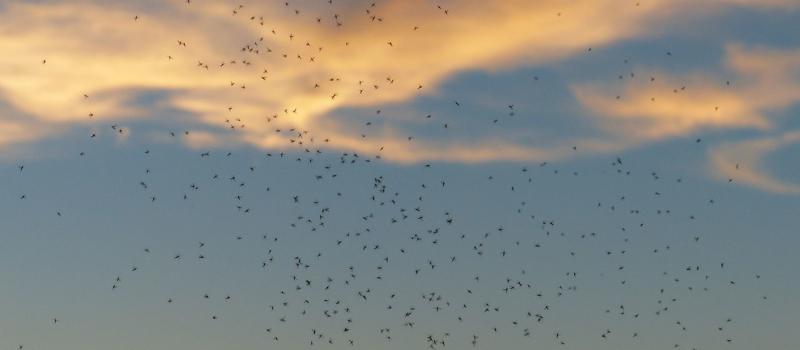Little Midge, Big, Annoying Bite
Posted by Mosquito Squad
May 29, 2020

What is a midge? Some would say that no summer is complete without them. While a single image may come to mind when you hear the term biting midge (or biting gnat), the term is generally used to describe the fly from the family Ceratopogonidae.
At beaches and in backyards across the country, they’re also commonly referred to as no-see-ums and sandflies. But no matter what you call them – they’re a nuisance.
Learn more about these pesky insects, and how to treat a bite!
What Are Biting Midges?
Biting midges are tiny, two-wing insects that are known for breeding in moist, organic material and have a knack for inflicting painful, itchy bites. For a being that spans no more than a quarter-inch, biting midges can pack a powerful punch. Both male and female biting midges feed on plant nectar. However, while males can survive on nectar alone, females need to feed on blood to produce their eggs by using mouthparts developed for cutting into skin. This is why humans and pets make perfect targets.
Are Midge Bites Dangerous?
Not to humans or pets. Biting midges are not significant vectors for human diseases, though some species can transmit pathogens such as bluetongue virus to deer, sheep, and cattle.
Identifying Biting Midge Bites
On humans, their bites look like small, red lumps and are incredibly itchy, sometimes painful, and can become swollen. On dogs, midge bites are usually found on their stomachs and produce small, itchy red lumps similar to those found on people.
How Long Do Midge Bites Last?
While it can feel like the itch lasts forever, most bites clear up within a week. However, excessive scratching of the bite can damage the skin and make the wound more pronounced, prolonging the healing process. And no, you’re not imagining it – the bites can be itchier at night. Doctors attribute this to the fact that cortisol (our built-in anti-inflammatory hormone) levels are higher in the morning than at night. It also comes down to mind over matter – our brains have fewer distractions to process at bedtime, which puts midge (or any insect) bites top of mind.
How to Treat Midge Bites
If you’re bitten, follow these steps for treating midge bites:
- First, wash the area with soap and water.
- If the bite is bleeding, it’s smart to apply a little antiseptic ointment after you clean it.
- If the bitten area is swollen and irritated, you can apply a cold compress to reduce the irritation.
- From there, you can apply an over-the-counter anti-itch cream to the affected area. Because antihistamines found in anti-itch creams treat allergic reactions, an over-the-counter cream could also help reduce itchiness.
- Always follow packaging instructions for these products, and if you’re prone to sensitive skin or allergic reactions, check with your doctor before treating the bite(s) yourself.
- If necessary, reapply the cold compress or ice pack to help relieve the need to scratch your itch. If this doesn’t help, consider applying a bandage or wrap to the affected area.
Like with any reaction to an insect bite, if you do experience unusual sensitivity such as burning, blistering, or welting due to a midge bite, seek medical attention. Additionally, if the pain or swelling hasn’t reduced after a few days, be sure to see a doctor. You may be having an allergic reaction, or the bite may be infected.
How to Prevent Midge Bites
One of the best ways to prevent midge bites is to wear EPA-registered insect repellent, especially if you’re wearing clothes that expose large areas of skin. Biting midges can’t bite through thicker clothing materials, but they can get underneath them. When enjoying outdoor activities, like hiking, it’s best to wear long sleeves or pants.
Aside from protective repellent and the appropriate clothing, you can also take preventive measures such as:
- Being aware of when and where midges are active in your region (coastal, swampy areas in the late afternoon or evening).
- Burn citronella candles nearby as a natural repellent.
- Seal any gaps around the home and make sure screens aren’t torn or damaged.
- Schedule Squad Home Shield service for around your home. We also recommend an automatic misting system to control populations in your yard by killing the midges on contact and then preventing them from continuing to thrive in areas of your yard.
Fight the Bite with Professional Pest Treatment
The only tried and true way to avoid biting midges is by not having them in your yard. Our team can target places they breed and thrive and kill biting midges on contact with a professional treatment. Contact us for a free quote, or call us at (877) 332-2239 today!
